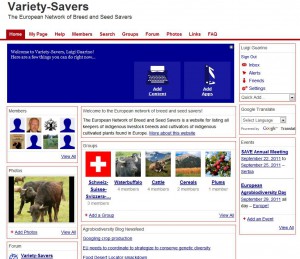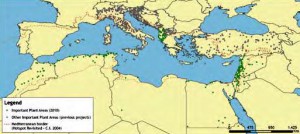- Sustainable fashion, darling.
- “The world’s leading international researchers will review the history of climate change, appraise the current state of the science and identify adaptations for the future.” It says here.
- Fiji suddenly discovers yams.
- Genebank romance in Durango. Well, that felt good.
- Animal Genetic Resources vol 8 is out.
- Locavores go crazy on Guam.
- Cocoa origins celebrated. And why not?
- Seems like every few months there’s something else on how those southern Iraq marshes are being brought back to life. But what I really want to know, and nobody is saying, is if there are any crop wild relatives there.
Variety Savers of Europe try to unite
The European Network of Breed and Seed Savers is a website for listing all keepers of indigenous livestock breeds and culivators of indigenous cultivated plants found in Europe. Variety-Savers should be used to network, to share information, to list events and to sell products and services relating to conservation of European agrobiodiversity.
 Just off the ground, and only 14 members so far, but this looks like an interesting initiative. Especially if it manages to bring formal-sector genebanks closer together with on-farm conservation practitioners and amateur heirloom enthusiasts. You do have to register, but it’s fairly painless, and the website provides some fancy social networking tools. Very best wishes!
Just off the ground, and only 14 members so far, but this looks like an interesting initiative. Especially if it manages to bring formal-sector genebanks closer together with on-farm conservation practitioners and amateur heirloom enthusiasts. You do have to register, but it’s fairly painless, and the website provides some fancy social networking tools. Very best wishes!
Important Plant Areas documented
More than 200 areas across North Africa and the Middle East have been identified as wild plant hotspots, a report has revealed. The research lists 207 places which are internationally important for the plants they contain, including 33 in Syria, 20 in Lebanon, 20 in Egypt, 21 in Algeria, 13 in Tunisia and five in Libya.
 The report in question is “Important Plant Areas of the south and east Mediterranean region,” ((Radford, E.A., Catullo, G. and Montmollin, B. de. (eds.) (2011). Important Plant Areas of the south and east Mediterranean region: priority sites for conservation. IUCN, Gland, Switzerland and Malaga, Spain. Gland, Switzerland and Malaga, Spain: IUCN. VIII + 108 pp.)) just out thanks to IUCN, Plantlife International and WWF, and downloadable for free. The maps are nice, of course, and I hope they’ll be available in digital form in due course, if they are not already. ((I’ll have a look around when I have a minute.)) And it is also great to see a list of species with restricted ranges; it includes quite a few crop wild relatives, in particular Allium and Vicia spp.
The report in question is “Important Plant Areas of the south and east Mediterranean region,” ((Radford, E.A., Catullo, G. and Montmollin, B. de. (eds.) (2011). Important Plant Areas of the south and east Mediterranean region: priority sites for conservation. IUCN, Gland, Switzerland and Malaga, Spain. Gland, Switzerland and Malaga, Spain: IUCN. VIII + 108 pp.)) just out thanks to IUCN, Plantlife International and WWF, and downloadable for free. The maps are nice, of course, and I hope they’ll be available in digital form in due course, if they are not already. ((I’ll have a look around when I have a minute.)) And it is also great to see a list of species with restricted ranges; it includes quite a few crop wild relatives, in particular Allium and Vicia spp.
Nibbles: Date palm sex, Heirlooms congress, World Camel Day, Latino livestock, Coconut craft, Hybridizing Alocasia, Sami reindeer, Serbian agri-environments, Honey, Feidherbia
- Qataris work out how to sex date palms.
- The National Heirloom Exposition revs its engine.
- World Camel Day is coming up. No, really.
- Latin Americans planning their next congress on the biodiversity of domestic animals. Cuy, anyone?
- The Art of Coconut Craft. Wonderfully kitschy.
- So, you want to breed Alocasia, do you?
- Sweden stops oppressing its main minority.
- High Nature Value farming in Serbia.
- Non-wood forest products are all very well, but…
- Yes, yes, Feidherbia will solve all the problems of the Sahel, now can I go back to sleep?
The 8th annual Great Lakes Indigenous Farming Conference passes us by
…Caroline [Chartrand] and about 100 other indigenous farmers and gardeners—along with students and community members—gathered in March on the White Earth reservation in Northern Minnesota to share knowledge, stories, and, of course, seeds.
Don’t know how we missed this from yes! magazine a couple of weeks back. In particular as one of the stories was about Pawnee corn, a topic we have covered here a number of times.